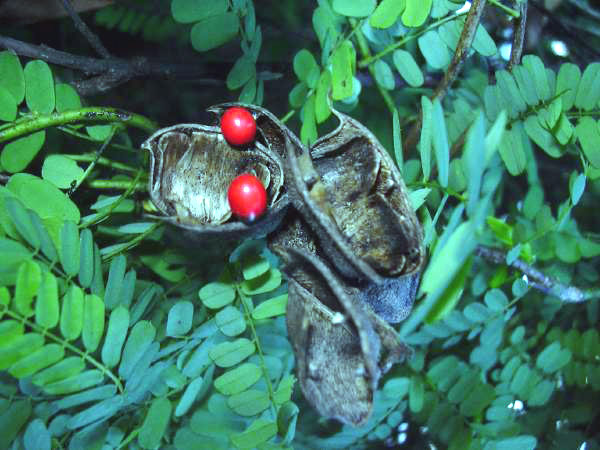- Abrus precatorius
Taxobox
name = Jequirity

image_width = 250px
regnum =Plant ae
divisio = Magnoliophyta
classis = Magnoliopsida
ordo =Fabales
familia =Fabaceae
subfamilia =Faboideae
tribus =Abreae
genus = "Abrus "
species = "A. precatorius"
binomial = "Abrus precatorius"
binomial_authority = L."Abrus precatorius", known commonly as Jequirity, Crab's Eye, Rosary Pea, John Crow Bead, Precatory bean, Indian Licorice or Saga Tree ("Abrus precatorius"), is a
legume with long, pinnate-leafleted leaves. It is also known as "Gunja" inSanskrit and some Indian languages. Theirseed s are often used as beads and in percussion instruments. The seed contains a toxicpoison Abrin that is only harmful when swallowed if the seeds are broken, as they have a hard seed coat. The plant is native toIndonesia and grows in tropical and subtropical areas of the world where it has been introduced. It has a tendency to becomeweed y and invasive where it has been introduced.Toxin
The
toxin present in "Abrus precatorius" is a close relative toricin called abrin. It is adimer consisting of twoprotein subunit s, termed A and B. The B chain facilitates abrin's entry into a cell by bonding to certaintransport protein s oncell membrane s, which then transport the toxin into the cell. Once inside the cell, the A chain preventsprotein synthesis by inactivating the 26S subunit of theribosome . One molecule of abrin will inactivate up to 1,500ribosome s per second. Symptoms are identical to those of ricin, except that the fatal dose of ricin is approximately 75 times greater than the fatal dose of abrin. Abrin can kill with a circulating amount of less than 3 μg (microgram s).Uses
The seeds of "Abrus precatorius" are much valued in native
jewelry for their bright coloration. The third of the bean with the hilum (attachment scar) is black, and the rest is bright red, suggesting aladybug . Jewelry-making with jequirity seeds is dangerous, and there have been cases of death by a finger-prick while boring the seeds for beadwork. However, it has long been a symbol of love in China.References
*
List of plants of Caatinga vegetation of Brazil
* [http://www.weberseeds.de/species/abrus_precatorius.htm Abrus precatorius seed (extremeclose-up)]
Wikimedia Foundation. 2010.
